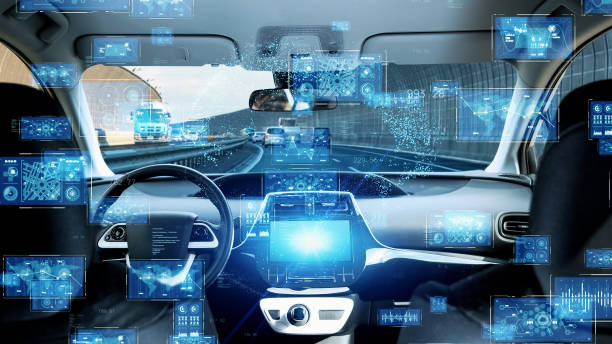Holograms on the Highway: The Future of Automotive Displays
The gleaming curves of a classic muscle car shimmer in the sunlight, its sleek lines uninterrupted by clunky gauges or screens. As you slide into the driver's seat, the dashboard comes alive with a holographic display, floating ethereally before your eyes. This isn't science fiction – it's the cutting-edge world of holographic automotive displays, poised to revolutionize how we interact with our vehicles.

The Evolution of Automotive Displays
The history of automotive displays traces back to the earliest days of motoring. Early cars featured simple analog gauges, typically showing only the most essential information like speed and fuel level. As automotive technology advanced, so did the complexity and variety of information presented to drivers.
The digital revolution brought LED and LCD screens to vehicle dashboards, allowing for more dynamic and customizable displays. Head-up displays (HUDs) projected basic information onto the windshield, keeping drivers’ eyes on the road. However, these technologies still relied on flat, two-dimensional presentations of data.
Holographic displays represent the next leap forward, offering three-dimensional, floating images that can be positioned anywhere within the driver’s field of view. This technology has the potential to present information in a more intuitive and less distracting manner, fundamentally changing how drivers interact with their vehicles.
The Technology Behind Automotive Holograms
At its core, holographic display technology relies on the principles of light diffraction and interference to create the illusion of three-dimensional objects floating in space. In automotive applications, this is typically achieved through a combination of advanced optics, high-resolution projectors, and sophisticated software.
One approach uses a transparent film applied to the windshield or side windows. This film acts as a diffraction grating, bending light from projectors hidden within the dashboard to create floating images. Another method employs micro-mirror arrays to reflect light in precise patterns, forming 3D images in mid-air.
The most advanced systems incorporate eye-tracking technology to adjust the hologram’s position based on the driver’s head movement, ensuring the display remains clear and properly aligned from any angle. This dynamic adjustment is crucial for maintaining the illusion of depth and preventing distortion.
Enhancing Safety and User Experience
Holographic displays have the potential to significantly improve driver safety by presenting information in a more intuitive and less distracting manner. Unlike traditional displays that require drivers to shift their gaze away from the road, holograms can be positioned directly in the line of sight, minimizing eye movement and refocusing time.
These displays can also take advantage of depth perception to convey information more effectively. For example, a holographic navigation system could project turn arrows that appear to float above the actual intersection, making directions clearer and more intuitive. Similarly, warning indicators could grow larger or move closer as potential hazards become more imminent, providing a more natural sense of urgency.
Beyond safety, holographic displays offer new possibilities for personalization and user experience. Drivers could customize their dashboard layout, choosing which information to display and where. The technology could also enable more immersive infotainment experiences, such as three-dimensional maps or virtual concerts that seem to float in the passenger seat.
Challenges and Limitations
Despite their potential, holographic displays face several challenges before they can become mainstream in automotive applications. One of the primary hurdles is brightness and visibility. Holograms must be bright enough to be clearly visible in varying lighting conditions, from direct sunlight to nighttime driving, without causing glare or distraction.
Another significant challenge is the computational power required to generate and update complex 3D images in real-time. This demands powerful onboard computers and sophisticated software, which can add considerable cost and complexity to vehicle systems.
Durability and reliability are also crucial considerations. Automotive components must withstand years of use in harsh conditions, including extreme temperatures and constant vibration. Ensuring that delicate holographic systems can meet these demanding requirements presents a significant engineering challenge.
The Road Ahead for Automotive Holograms
As technology continues to advance, many of these challenges are being addressed. Several major automotive manufacturers and technology companies are investing heavily in holographic display research and development. Some luxury vehicles already feature limited holographic elements, such as enhanced HUDs, paving the way for more advanced applications.
In the coming years, we can expect to see holographic displays become increasingly common, starting with high-end vehicles and gradually filtering down to more mainstream models. As the technology matures, costs will likely decrease, making it more accessible to a broader range of consumers.
The integration of holographic displays with other emerging automotive technologies, such as augmented reality and advanced driver assistance systems, holds even more promise. Imagine a holographic display that not only shows navigation information but also highlights potential hazards in the road ahead or displays the optimal driving line on a racetrack.
As we look to the future of automotive design and technology, holographic displays stand out as a transformative innovation. By presenting information in a more intuitive, immersive, and less distracting manner, they have the potential to enhance both the safety and enjoyment of driving. While challenges remain, the continued development of this technology promises to bring the futuristic world of floating, three-dimensional displays from science fiction into our everyday driving experience.





